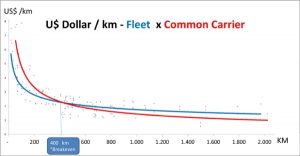 Lifespan has a history of working with research institutions around the U.S. and the globe in our ongoing efforts to improve service for our customers and to stay at the forefront of our industry.
Lifespan has a history of working with research institutions around the U.S. and the globe in our ongoing efforts to improve service for our customers and to stay at the forefront of our industry.
In January, we met with researchers from MIT at the Global Supply Chain and Logistics Excellence (SCALE) Network to discuss how we can improve our logistics capabilities to our customers.
A common myth in our industry is that owning a truck fleet and using only those company-owned vehicles for transportation is the ideal solution for moving ITAD material. To the contrary, research conducted at MIT by Renato Starling shows that there is an inflection point beyond which it is more efficient to provide services with a hybrid of private fleet and common carriers. Starling published his findings and analysis: “Choice Between Private Fleet and Common Carrier.”
In Starling’s study, he worked with a multinational consumer products company to evaluate the private fleet cost for each transportation lane. Considerations in the analysis included:
- Labor
- Equipment Depreciation
- Fuel
- Maintenance
- Tolls
- Tires
- Other operating charges
In the graph above, the comparison demonstrates the fleet vs common carrier costs. For this company and market, lanes longer than 400 km, a common carrier is more competitive than private fleet.
Lifespan’s operational experience has been similar. When it makes sense, Lifespan uses its own logistics resources in regional hubs and then uses common carriers and third-party vendors for longer distances.
Lifespan has found that a mix of our own fleet complimented with a screened and secure network of contracted national and local carriers is an optimal solution to reduce cost and manage complex, highly distributed, enormous volume pickups (trailer loads on a single transaction) or very small pickups (1 pallet or less) in distant cities.
An experienced ITAD professional can provide you with options for logistics based on your requirements, taking into consideration the location, facility access, amount of equipment, on-site services required, and security. You can start an email or phone conversation with one of Lifespan’s experts by clicking here.


